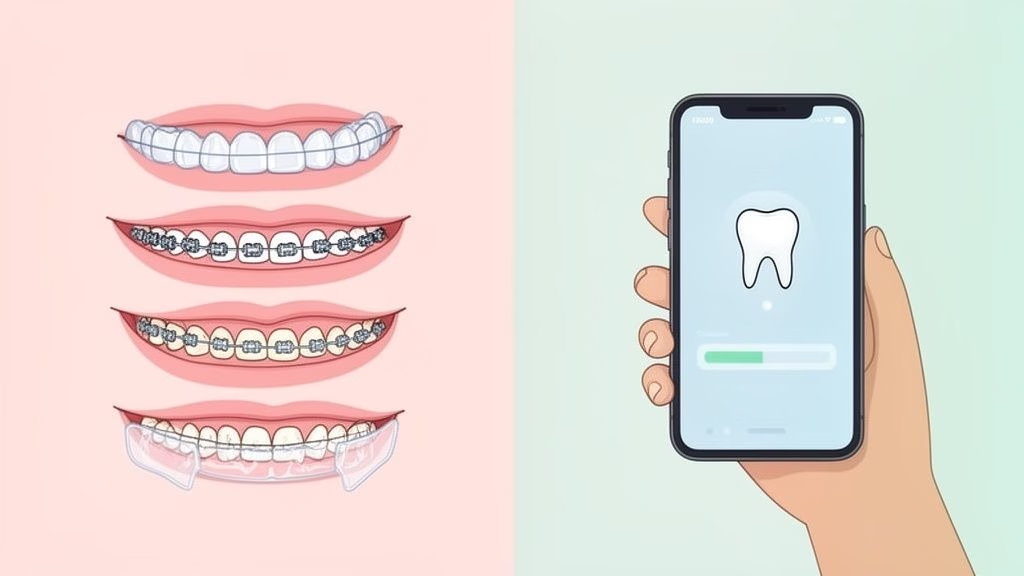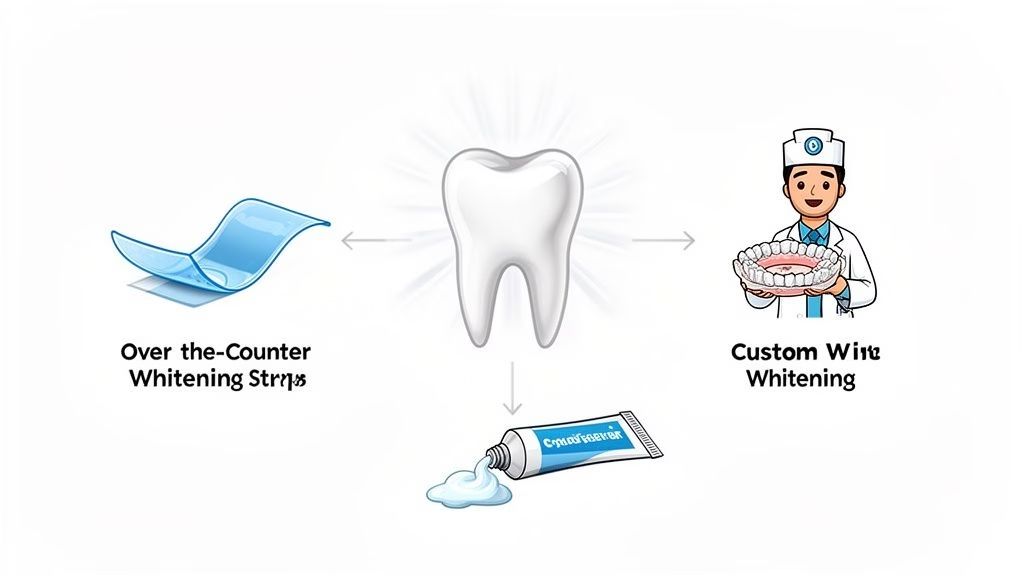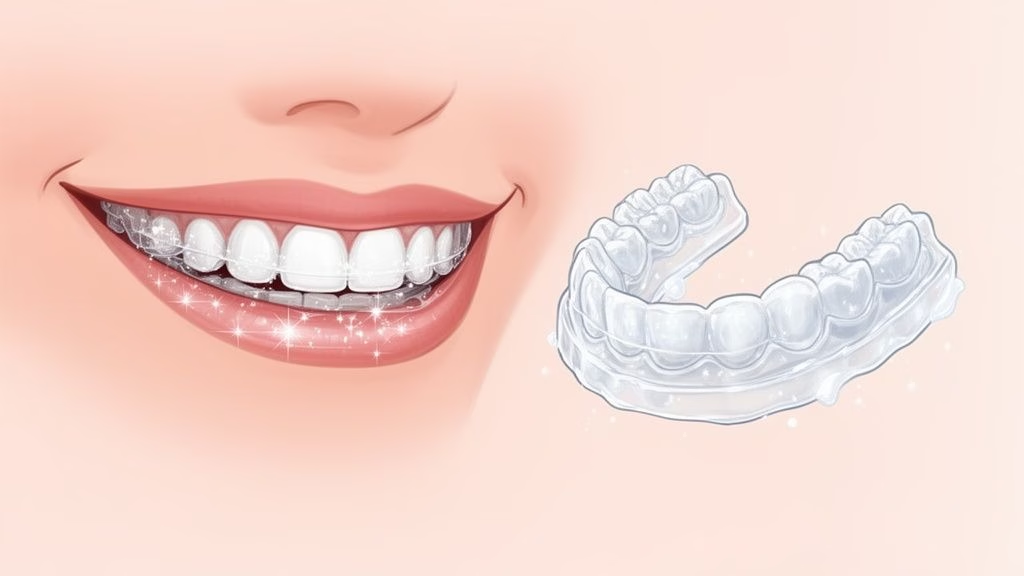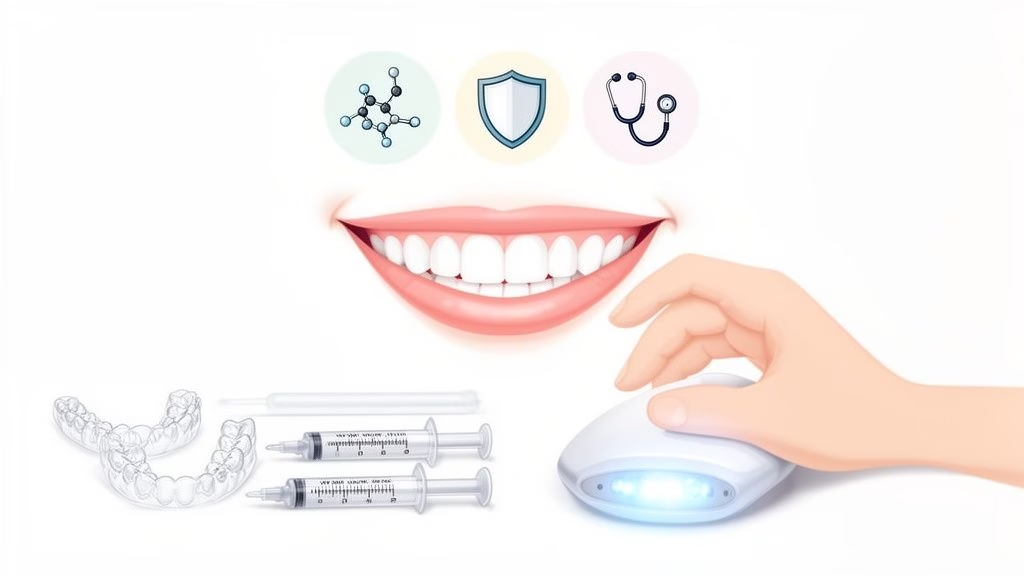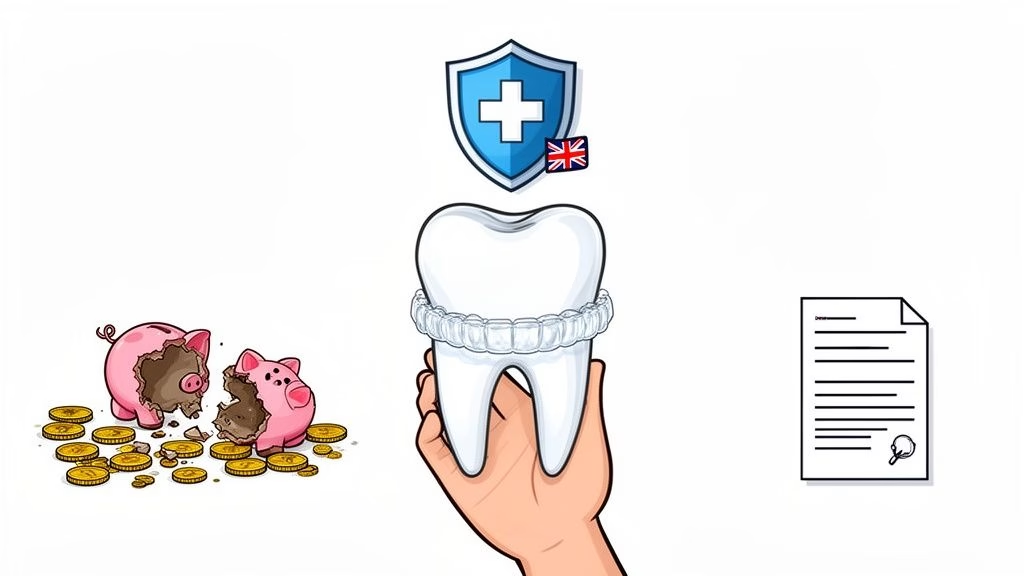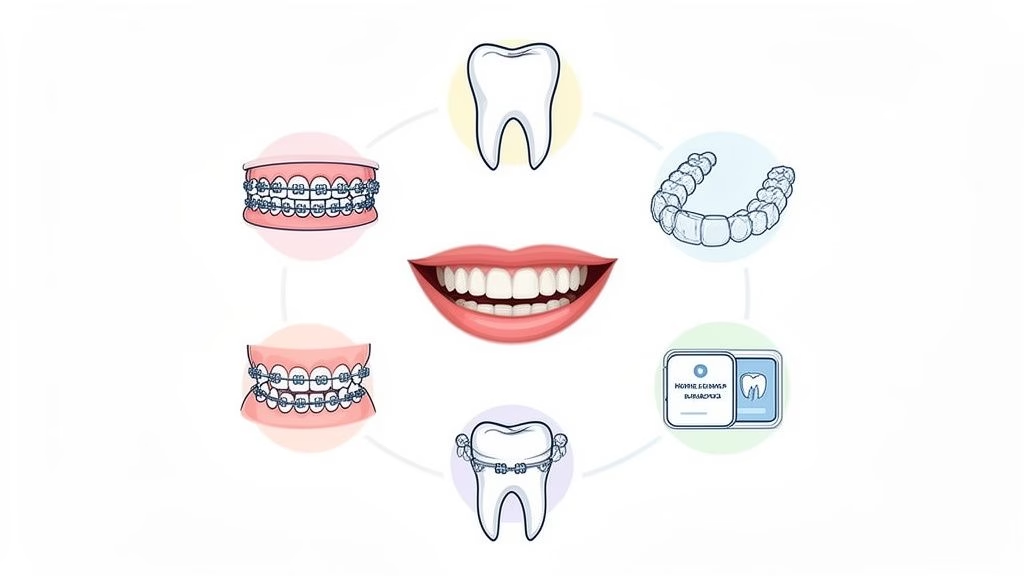A UK Guide to Retainers for Teeth Straightening
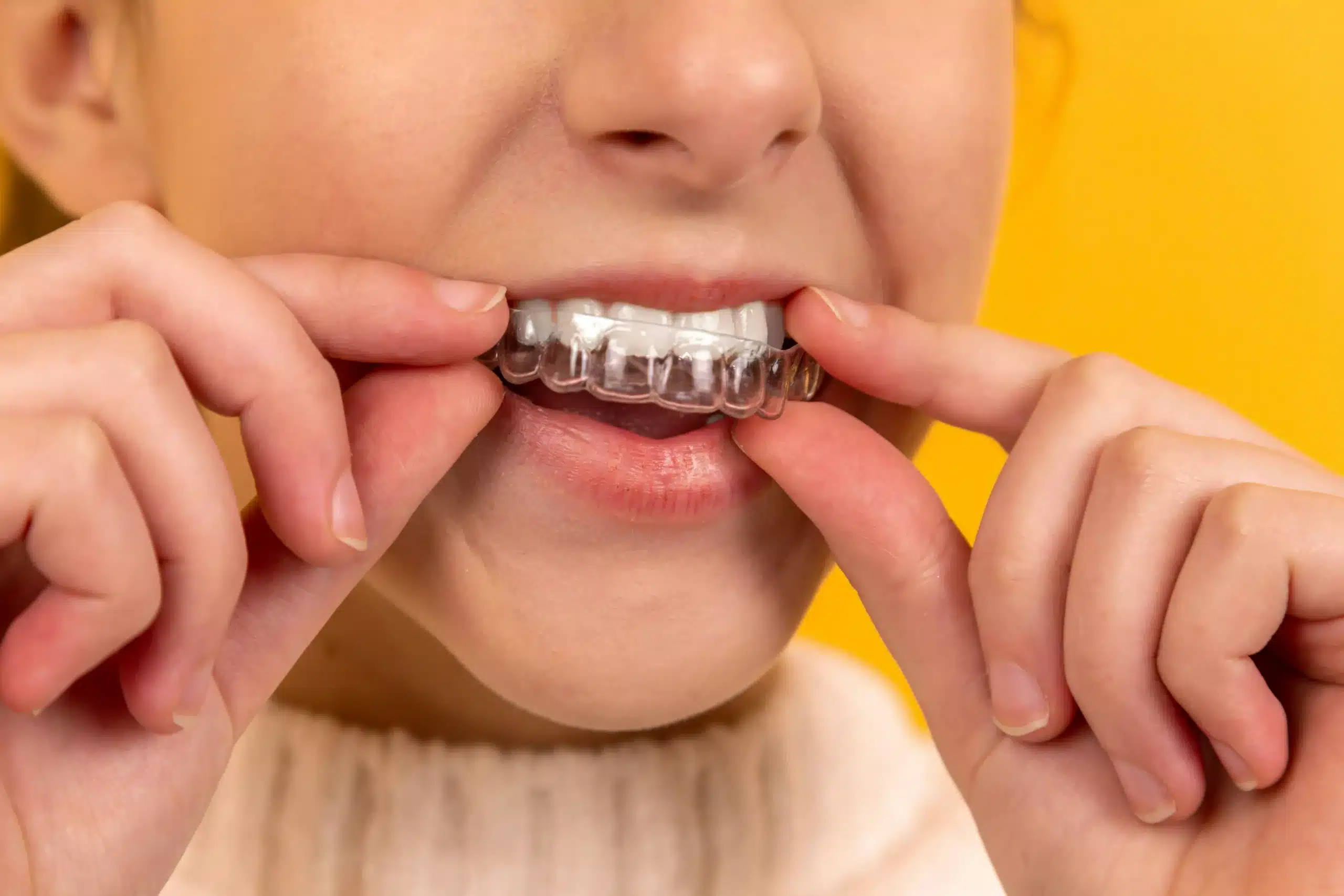
You’ve done it. After months or even years of treatment, you’ve finally achieved the straight, beautiful smile you’ve been working towards. It’s a huge milestone, but your journey isn’t quite over. The next, and arguably most important, step is all about making sure that perfect smile lasts a lifetime. That’s where retainers come in.
These custom-made devices are designed to do one simple but critical job: hold your teeth firmly in their new positions. Think of them as the guardians of your smile.
Why Your Smile Journey Depends on Retainers

Getting your braces off or finishing your last aligner tray feels fantastic. You’ve invested time, effort, and money into this transformation. But what many people don’t realise is that the work isn’t finished. Now, it’s all about preservation, and your retainer is the star of the show.
Without consistent use, you’ll almost certainly face something dentists call orthodontic relapse.
What Is Orthodontic Relapse?
Orthodontic relapse is the very natural tendency for your teeth to drift back toward their original, misaligned positions. It’s not a sign that your treatment failed; it’s just biology at work. The ligaments and bone that hold your teeth in your jaw have a kind of “memory” of where they used to be.
Think of it like this: your newly straightened teeth are like freshly poured concrete. At first, it’s soft and needs a mould to hold its shape. Your retainer is that mould. It provides the stability needed for the surrounding bone and tissues to firm up and secure your teeth in their new home.
Everyday forces from chewing, talking, and even just your tongue pressing against your teeth can gradually nudge them out of alignment. This is why your orthodontist insists on retainer wear—it’s not just a friendly suggestion. It’s the only way to guarantee the long-term success of your treatment. Understanding this is key, just like it was when you were initially choosing between clear aligners and traditional braces.
A Quick Look at Your Retainer Options
To help you understand the types of retainers available in the UK, here’s a quick summary. Each has its own strengths, and the right one for you will depend on your orthodontist’s recommendation and your personal preferences.
| Retainer Type | Key Feature | Ideal For |
|---|---|---|
| Fixed Retainer | A thin wire bonded permanently to your teeth’s back. | Patients who want a “set-and-forget” solution and are at high risk of relapse. |
| Hawley Retainer | A removable plate with a metal wire. | Durability and allowing for minor adjustments if needed. |
| Clear Retainer | A transparent, removable plastic tray. | Patients looking for a discreet and comfortable option. |
Ultimately, all these options are designed to do the same job: protect your investment and keep your smile looking its best for years to come.
Protecting Your Investment the Smart Way
In the UK, orthodontists view retainers as the essential final phase of treatment. After all that dedication, you need to wear one to maintain the results—often for life.
This lifelong commitment can feel a bit overwhelming, especially when you think about the cost and hassle of getting replacements from a traditional dental practice. This is where a more modern approach can make a world of difference.
At Toothfairy, we’ve created a smarter, more affordable way to handle this crucial stage. Our direct, digital model makes getting high-quality, custom-fit retainers much simpler and more accessible. We believe that protecting your investment shouldn’t be a chore, so you can enjoy your fantastic smile for decades without the old-fashioned fuss.
Choosing Your Removable Retainer
So, you’ve done the hard work and your teeth are finally straight. Congratulations! The next, equally crucial, step is making sure they stay that way. For most people, a removable retainer is the way to go, giving you the freedom to pop it out for meals and cleaning.
They’re custom-made to fit your mouth like a glove, holding everything perfectly in position. In the UK, you’ll generally come across two main options: the classic Hawley retainer and the more modern clear plastic versions. Let’s break down the differences so you and your dentist can figure out what’s best for you.
The Traditional Workhorse: The Hawley Retainer
You’ve almost certainly seen a Hawley retainer, even if you didn’t know its name. It’s that classic design with a coloured acrylic plate sitting snug against the roof of your mouth (or behind your bottom teeth) and a thin metal wire that runs neatly across the front.
It’s been an orthodontic staple for decades, and for very good reasons.
- Durability: These things are built to last. Made from tough, sturdy materials, a well-cared-for Hawley retainer can be your smile’s best friend for years.
- Adjustability: One of its standout features is that your dentist can make tiny tweaks to the wire. If a tooth decides to shift ever so slightly, the retainer can often be adjusted to nudge it back into line.
- Longevity: Thanks to their solid build, they often outlive their plastic cousins, which could save you a bit of money on replacements down the line.
Of course, the Hawley retainer isn’t perfect for everyone. The most obvious downside is the look – that metal wire is quite visible. Some people also find the acrylic plate feels a bit bulky at first and might affect their speech for a day or two while they get used to it.
The Modern, Invisible Shield: The Clear Retainer
Lately, clear retainers—you might hear them called Essix retainers—have soared in popularity. Think of them as a thin, transparent plastic tray that fits perfectly over all your teeth, looking a lot like the clear aligners you may have used for your treatment. They’re moulded from a precise 3D scan or impression of your newly straightened smile.
It’s easy to see why they’ve become so popular. A clear retainer is like an invisible shield, locking your teeth in place without anyone else being any the wiser. This makes it a fantastic choice for adults and teens who want to protect their investment without the visual clutter of traditional hardware.
These clear retainers are designed for discretion and comfort. They offer a seamless transition from clear aligner therapy, as patients are already accustomed to the feel of a full-coverage tray. The near-invisibility is a major factor in why patients consistently choose and wear them.
Providers like Toothfairy specialise in creating high-quality, custom-fit clear retainers because they deliver what most people are looking for today: a solution that is effective, affordable, and discreet. While they are incredibly effective retainers for teeth straightening, they do need a bit of careful handling. They aren’t as tough as a Hawley and can warp if you expose them to heat, so always clean them with cool water and keep them safe in their case.
Exploring the Permanent Retainer Option
For anyone who loves a ‘set-it-and-forget-it’ approach, the permanent retainer is a pretty compelling option. Unlike its removable cousins, this retainer works around the clock to protect your smile, offering constant reassurance without you having to lift a finger.
So, what is it exactly? A permanent retainer—often called a fixed or bonded retainer—is a very thin piece of solid or braided wire, custom-shaped for your teeth. It’s discreetly bonded to the back of your front teeth, typically the lower six, but sometimes the upper ones too. This placement makes it completely invisible to everyone else.
Who Benefits Most from a Permanent Retainer
While that hands-off convenience sounds great, fixed retainers are usually recommended for people with a higher risk of their teeth shifting back. This often includes cases where there were big gaps between the front teeth or significant crowding before treatment began. In these situations, teeth have a stronger ‘memory’ of their old positions and are just more likely to move.
Think of a permanent retainer as a constant, gentle guard, preventing even the slightest drift. It’s the perfect solution for anyone who worries they might forget to wear a removable device as often as they should. The peace of mind that comes from knowing your retainers for teeth straightening are always on the job is a massive plus.
However, this hassle-free device comes with its own set of rules, especially when it comes to oral hygiene. Because the wire is bonded directly to your teeth, it creates new little nooks and crannies where plaque and tartar can build up if you aren’t careful.
A fixed retainer provides excellent stability for the most mobile teeth in your mouth—the lower incisors. However, its effectiveness is directly tied to the patient’s ability to maintain excellent oral hygiene around the wire.
This doesn’t mean it’s difficult, but it does demand a bit more diligence. You can’t just run floss over the bonded area like you normally would. Instead, you’ll need to master a slightly different technique to keep everything healthy.
Tips for Maintaining Your Fixed Retainer
Keeping the area around your permanent retainer clean is crucial for preventing gum disease and cavities. It might take a little practice, but it will quickly become a normal part of your daily routine.
- Use a Floss Threader: This is a small, flexible tool that looks a bit like a plastic sewing needle. You simply guide your regular floss through its loop and then thread it under the retainer wire to clean between each tooth.
- Try Interdental Brushes: These tiny brushes are fantastic for getting into the small spaces between your teeth and underneath the wire. They come in various sizes, so you can find one that fits comfortably.
- Consider a Water Flosser: A water flosser can be a powerful ally. It uses a pressurised stream of water to flush out food particles and plaque from hard-to-reach spots, including all around your fixed retainer.
It’s also vital to stick to your regular dental check-ups and cleanings. Your hygienist has the professional tools and know-how to thoroughly clean around the retainer and spot any potential problems early on.
While Toothfairy champions the convenience and affordability of modern removable retainers, we recognise that a permanent retainer is sometimes the best clinical choice for long-term stability. The right option always comes down to your unique dental needs and lifestyle, ensuring your hard-earned smile stays perfect for years to come.
The Real Cost of Retainers in the UK
After you’ve gone through the whole process of straightening your teeth, the last thing you want is another bill. But here’s the reality: keeping that new smile perfect is a lifelong job, and that means factoring in the cost of retainers. The price for retainers for teeth straightening in the UK can really vary, and it’s an ongoing expense that often catches people off guard.
Think about it – from your first set to the replacements you’ll inevitably need down the line, the costs add up. A retainer that gets lost, stepped on, or just wears out over time isn’t just a hassle; it’s another hit to your wallet. It’s a genuine, long-term cost that really should be part of everyone’s initial budgeting for their smile journey.
Breaking Down Traditional Retainer Costs
When you go the traditional route and get retainers from your local high street dentist, you’re not just paying for the plastic. The price is bundled with the cost of multiple appointments, the clinic’s overheads, and the external lab fees they have to cover. While that’s the standard way of doing things, it can make looking after your straight teeth a lot more expensive than it needs to be.
Here’s a rough idea of what you could be looking at with a conventional dental practice:
- Initial Retainer Set: Your first set might be included in the total cost of your orthodontic treatment, but that’s not a given. If you’re billed for them separately, a single set for your upper and lower teeth could set you back anywhere from £150 to £500, sometimes even more.
- Replacement Fees: This is where the long-term costs really start to bite. A clear retainer might last a couple of years if you’re meticulous, but life happens. Replacing one can cost just as much as the first, and those fees can accumulate surprisingly fast over a decade.
- Appointment Costs: Misplace your retainer? You’ll probably need to book an appointment for a new 3D scan or a messy impression mould. That’s another charge on your bill before you’ve even paid for the new device itself.
The UK orthodontics market has exploded in recent years, which shows just how many of us are investing in our smiles. Yet, the price remains a major hurdle, not just for the initial treatment but for the crucial follow-up care with retainers. This ongoing financial pressure is a key reason why some people, unfortunately, give up on wearing their retainers, putting their results at risk. You can dig into the data on the UK orthodontics market to see just how significant these cost barriers are.
A Smarter, More Affordable Financial Path
Thankfully, the old-school model isn’t the only option anymore. The need for a more transparent, budget-friendly solution is exactly why Toothfairy came to be. By shipping directly to you, we sidestep the middlemen and the need for extra clinic visits, which means you see some serious savings.
The real value isn’t just in the lower price point, but in the empowerment it gives you. Knowing you can affordably replace a lost or old retainer without financial stress means you’re more likely to stick with it, ensuring your smile stays perfect for life.
Picture this: you’re on holiday and you lose your retainer. With a traditional dentist, you’d be looking at a stressful wait to get an appointment and a hefty bill when you get back. With a modern provider like Toothfairy, your digital dental records are already on file. We can get a new, perfectly fitting retainer ordered and sent straight to your door, often for a fraction of what you’d otherwise pay.
This isn’t about cutting corners; it’s about being more efficient. We provide the exact same high-quality, custom-made retainers for teeth straightening you’d get from a top clinic. The only difference is we’ve created a smarter process that makes it more accessible, and we pass those savings directly on to you. It turns the lifelong commitment to your smile from a financial burden into a simple, manageable part of your routine.
Here is the rewritten section, designed to sound like it was written by an experienced human expert.
Your Guide to Daily Retainer Care
So, you’ve got your new smile – now the mission is to keep it that way. Looking after your retainer is just as crucial as wearing it. A clean, well-cared-for retainer does its job properly and, just as importantly, keeps your mouth healthy. Let’s walk through some simple, daily habits for both removable and fixed retainers that will protect your investment for years to come.
Think of it as a small, daily deposit into your smile’s future. A couple of minutes a day is all it takes to stop bacteria from building up, keep clear retainers crystal clear, and make sure your device lasts as long as it should. It’s a tiny bit of effort for a massive payoff.
Cleaning Your Removable Retainer
Whether you have a clear plastic retainer or a classic Hawley, daily cleaning is non-negotiable. Your mouth is a busy place, and plaque and bacteria will happily set up camp on your retainer’s surface. This can lead to nasty smells, staining, and even oral health problems if you let it slide.
Here’s a simple routine to get into:
- Rinse Immediately: The moment you take your retainer out, give it a quick rinse under cool or lukewarm water. This simple step washes away saliva and plaque before they dry and become much harder to remove.
- Gentle Brushing: Grab a soft-bristled toothbrush (keep one just for your retainer) and a bit of mild, non-abrasive soap. Gently brush every nook and cranny. One key thing to avoid is regular toothpaste – its abrasive particles can create microscopic scratches on the surface, which are perfect hiding spots for bacteria.
- Rinse Thoroughly: Once it’s clean, rinse it well under cool water to get rid of any soap.
- Allow to Air Dry: Before popping it back in its case, let it air dry completely on a clean surface or pat it dry with a fresh cloth.
A word of warning: steer clear of hot water. It’s a classic mistake. High temperatures can easily warp the precision-moulded plastic of a clear retainer, permanently changing its shape and making it useless. Stick to cool or lukewarm water, always.
Do’s and Don’ts for Removable Retainer Care
A few ground rules will keep your removable retainer in pristine condition, whether it’s a modern clear one from a provider like Toothfairy or a traditional Hawley retainer from your orthodontist.
Do:
- Always use the case. This is rule number one for a reason. It’s your retainer’s best defence against being lost, sat on, or chucked in the bin.
- Clean it every day. Tack it onto your morning or evening routine, right alongside brushing your teeth.
- Keep it away from pets. You’d be surprised how many retainers fall victim to the family dog!
Don’t:
- Never wrap it in a napkin. This is the fastest way to accidentally throw your retainer away with your leftovers.
- Avoid harsh chemicals. Bleach, denture cleaners containing persulfates, and alcohol-heavy mouthwashes are too aggressive and can degrade the material over time.
- Don’t leave it in a hot car. Just like hot water, extreme heat will warp and ruin your retainer’s custom fit.
Building these simple habits means looking after your retainers for teeth straightening becomes second nature. It’s a small commitment that protects the time and money you’ve put into getting that perfect smile, ensuring it stays with you for life.
Choosing Your Retainer Provider in the UK
Once your teeth are straight, the next crucial step is getting the right retainer. It’s a decision just as important as the orthodontic treatment itself, and it really comes down to two paths: heading to a local orthodontist or opting for a modern, online provider.
For decades, the only way to get a retainer was to sit in a dentist’s chair. This traditional, in-person approach still makes sense for very complex cases that need close, hands-on supervision. But for most people, the old way isn’t the only way anymore—and often, it’s not the most efficient.
Times have changed, and so has dentistry. The idea that top-tier care can only happen inside a physical clinic is quickly becoming outdated, thanks to providers who are thinking differently about how to deliver great service.
The Traditional Route vs Modern Convenience
Going to a local orthodontist feels familiar. You book an appointment, travel to the clinic, get an impression taken with putty, and then come back another day to pick up your retainer. It’s a process that works, but it often brings higher costs, scheduling headaches, and time wasted in waiting rooms. It’s a model built for another era.
In contrast, modern providers like Toothfairy offer a more sensible alternative designed for how we live today. By using smart technology, we bring professional dental care right to your door, cutting out unnecessary travel and expenses. The benefits are pretty clear.
- Convenience: Order and receive your retainers without leaving home. From the at-home impression kit to direct delivery, the whole process is built around your life, not the other way around.
- Affordability: Without the massive overheads of a high-street clinic, we can pass those savings directly on to you. This makes protecting your smile for life much more accessible.
- Accessibility: It doesn’t matter if you’re in a big city or a quiet corner of the UK. High-quality care is always just a few clicks away.
This approach isn’t about cutting corners on quality; it’s about making it better and more efficient for you.
How Technology Ensures Professional Oversight
You might wonder if an online service can really match the professional standards of a clinic. It’s a fair question, but the reality is that technology often enhances the process. We rely on incredibly accurate at-home impression kits to create retainers that fit perfectly. Crucially, every single case is reviewed and managed by a qualified UK dentist, ensuring your care meets the highest clinical standards.
The growth of the UK dental market is being driven by a demand for discreet and effective retainers, especially the clear plastic type popular with adults. While clinics have been the go-to for years, new tech like 3D printing is making it easier to create precise, custom-made retainers remotely. You can read more about trends in the orthodontic retainer market to see how technology is reshaping patient care.
This modern approach challenges the old assumption that an expert needs to be in the same room as you. With secure digital platforms and constant professional oversight, you receive the same level of expertise as you would from a traditional practice, but with far more convenience and transparency.
The Smart Choice for Your Smile
For anyone in the UK who values their time as much as their health, the choice becomes pretty straightforward. While in-person visits certainly have their place, online providers deliver a compelling mix of affordability, convenience, and professional trust.
At Toothfairy, we’re committed to being that smarter choice for your lifelong smile care. We believe protecting the investment you’ve made in your teeth should be simple and stress-free. By combining expert dental knowledge with intuitive technology, we offer a better way to look after your smile for good.
Common Questions About Teeth Retainers
Even after getting to grips with the different retainers for teeth straightening, it’s totally normal to have a few questions buzzing around. This final section is all about giving you clear, practical answers to the queries we hear most often. We want you to feel completely confident about looking after your new smile.
How Long Will I Have to Wear My Retainer?
This is the big one, and the honest answer is that it’s a bit of a journey. Right after your braces or aligners come off, you’ll be in the most crucial phase. For the first few months, expect to wear your retainer full-time – that means about 22 hours a day. This is when your teeth are most likely to try and shift back, so it’s a non-negotiable step.
Once everything has had a chance to stabilise, your dentist will probably give you the green light to switch to nightly wear. For most people, this becomes a lifelong habit. Just think of it as the last step in your nightly routine, as essential as brushing your teeth.
What Should I Do If My Retainer Is Lost or Broken?
The simple answer? Act fast. Your teeth can start moving back to their old spots within just a few days, so this isn’t a “wait and see” situation. Get in touch with your provider straight away.
Your smile’s stability depends on quick action. Delaying a replacement for a lost or broken retainer is one of the most common reasons for orthodontic relapse.
This is where a modern provider like Toothfairy really comes in handy. Since we keep your digital scans securely on file, getting a new, perfectly fitting replacement is quick and straightforward. To avoid the panic altogether, always keep your retainer safe in its case when it’s not in your mouth.
My Teeth Have Shifted Slightly. Can a Retainer Fix Them?
A retainer’s main job is to hold teeth in place, not to make big moves. If you’ve noticed a tiny shift and your retainer feels a bit snug when you first put it in, it might be enough to gently nudge that tooth back into line.
However, if the shift is more noticeable, a retainer won’t fix it – and it probably won’t fit properly anyway. In that case, you’d likely need a short touch-up treatment with clear aligners to correct the relapse before being fitted for a new retainer. It’s a perfect example of why wearing your retainer consistently from day one is so important.
Is It Hard to Clean Around a Permanent Retainer?
It does need a bit of extra effort, but it’s nothing you can’t handle once you get into a rhythm. You can’t floss the normal way where the wire is, so you’ll just need to learn a new trick.
A floss threader or small interdental brushes will become your best friend for cleaning between the bonded teeth. It might add a minute or two to your daily routine, but it’s absolutely vital for stopping plaque build-up and keeping your gums healthy. Your dentist or hygienist will be happy to show you the best technique at your next check-up.
Ready to protect your smile the smart and affordable way? With Toothfairy, getting high-quality, custom-fit retainers is simpler than ever. Order from the comfort of your home and ensure your perfect smile lasts a lifetime. Explore our retainers today.
Last updated on August 22, 2025

Toothfairy Care Team
Toothfairy, is the world's smartest dental app, that connects patients to a dentist for a range of issues, from emergencies, cosmetics, prescriptions to virtual exams.
Toothfairy Care Team
Toothfairy, is the world's smartest dental app, that connects patients to a dentist for a range of issues, from emergencies, cosmetics, prescriptions to virtual exams.
